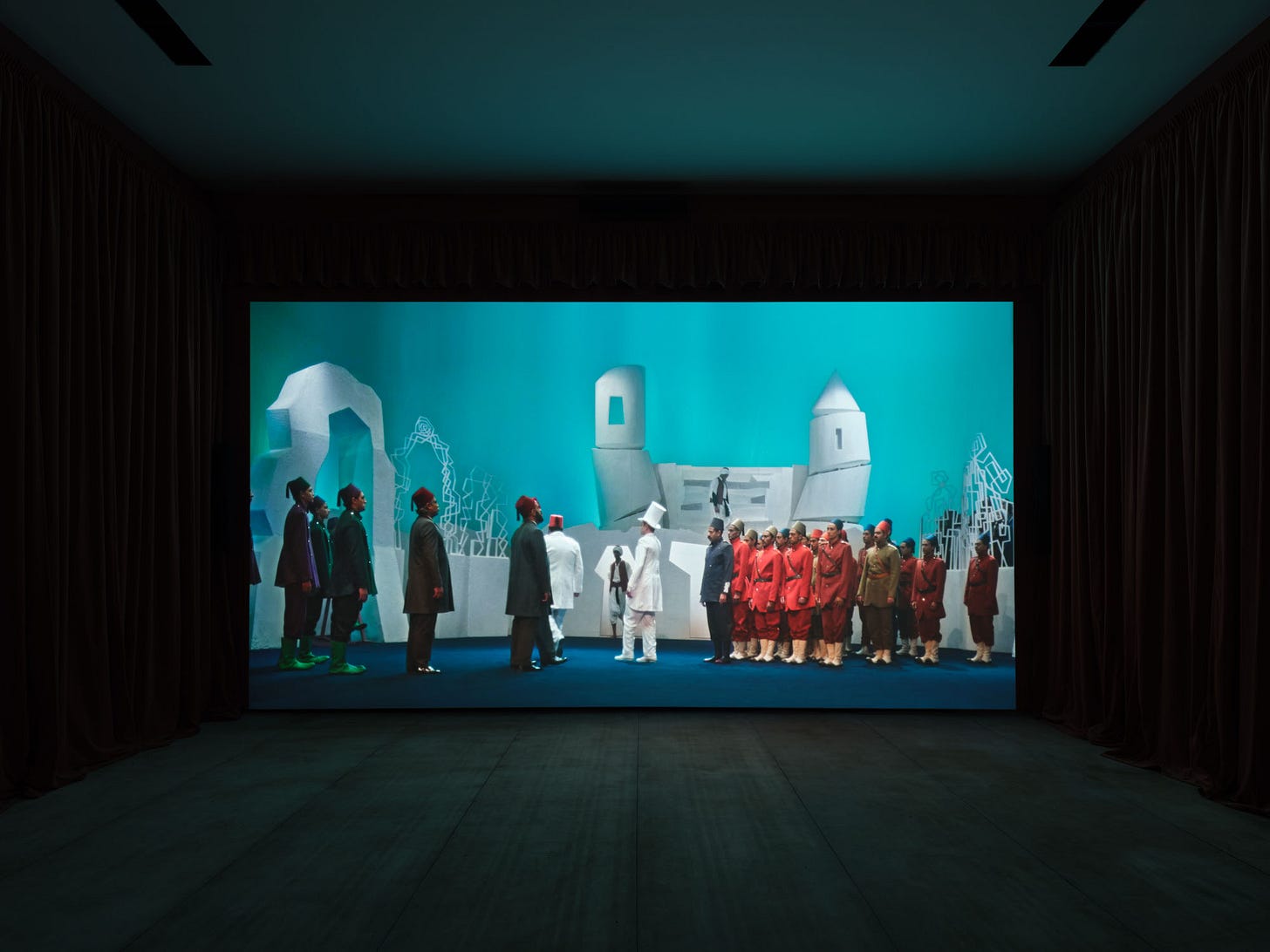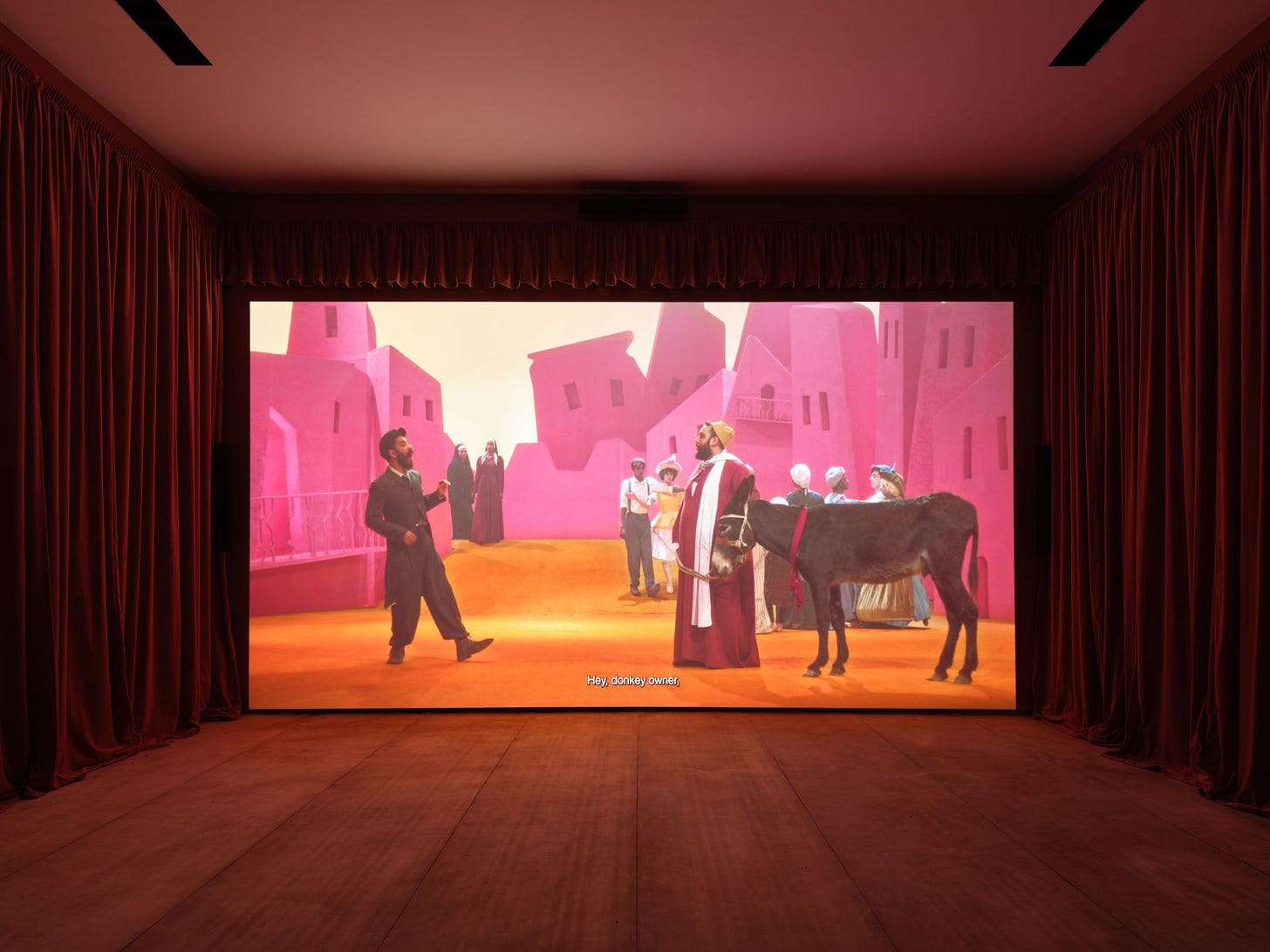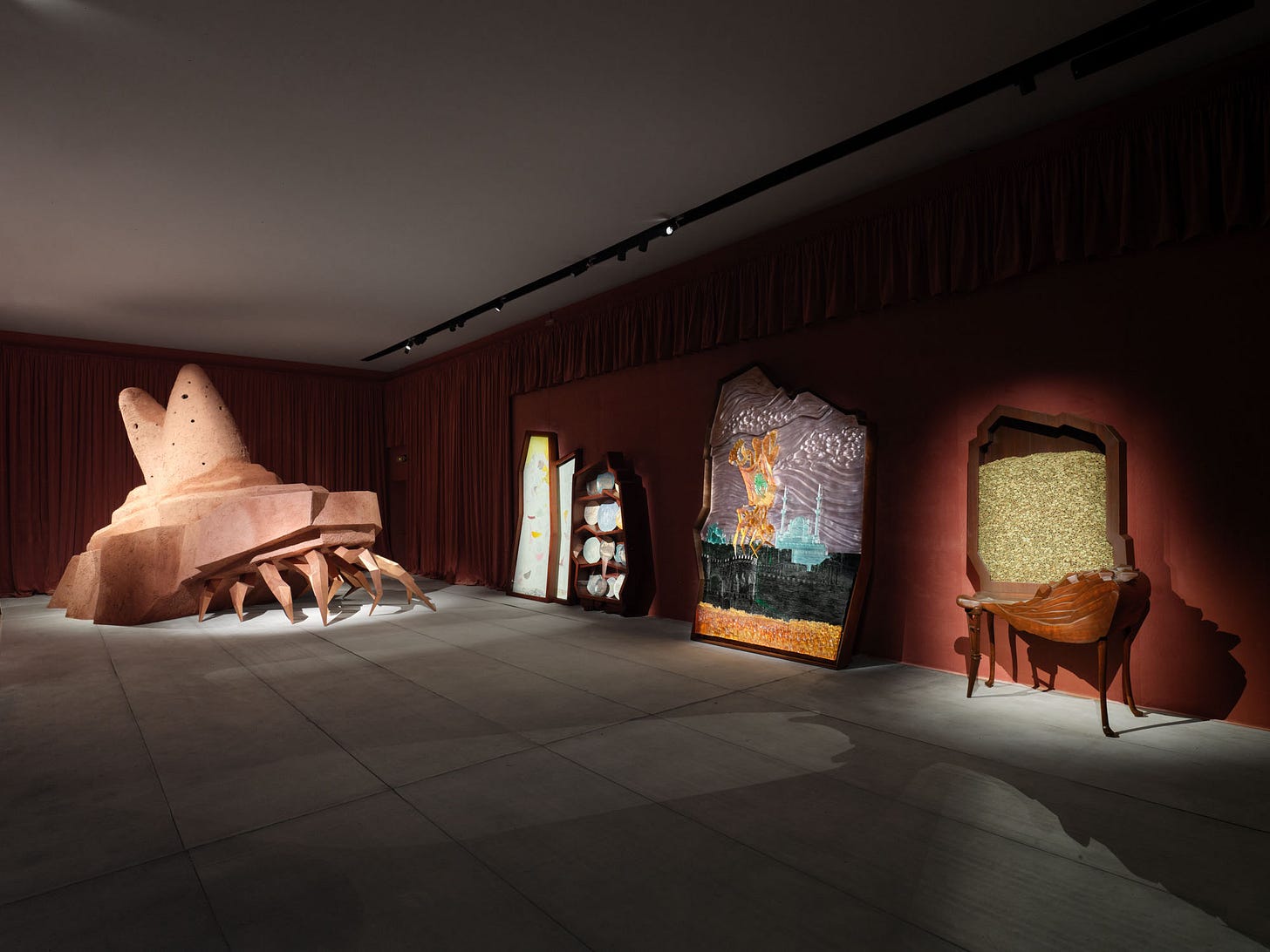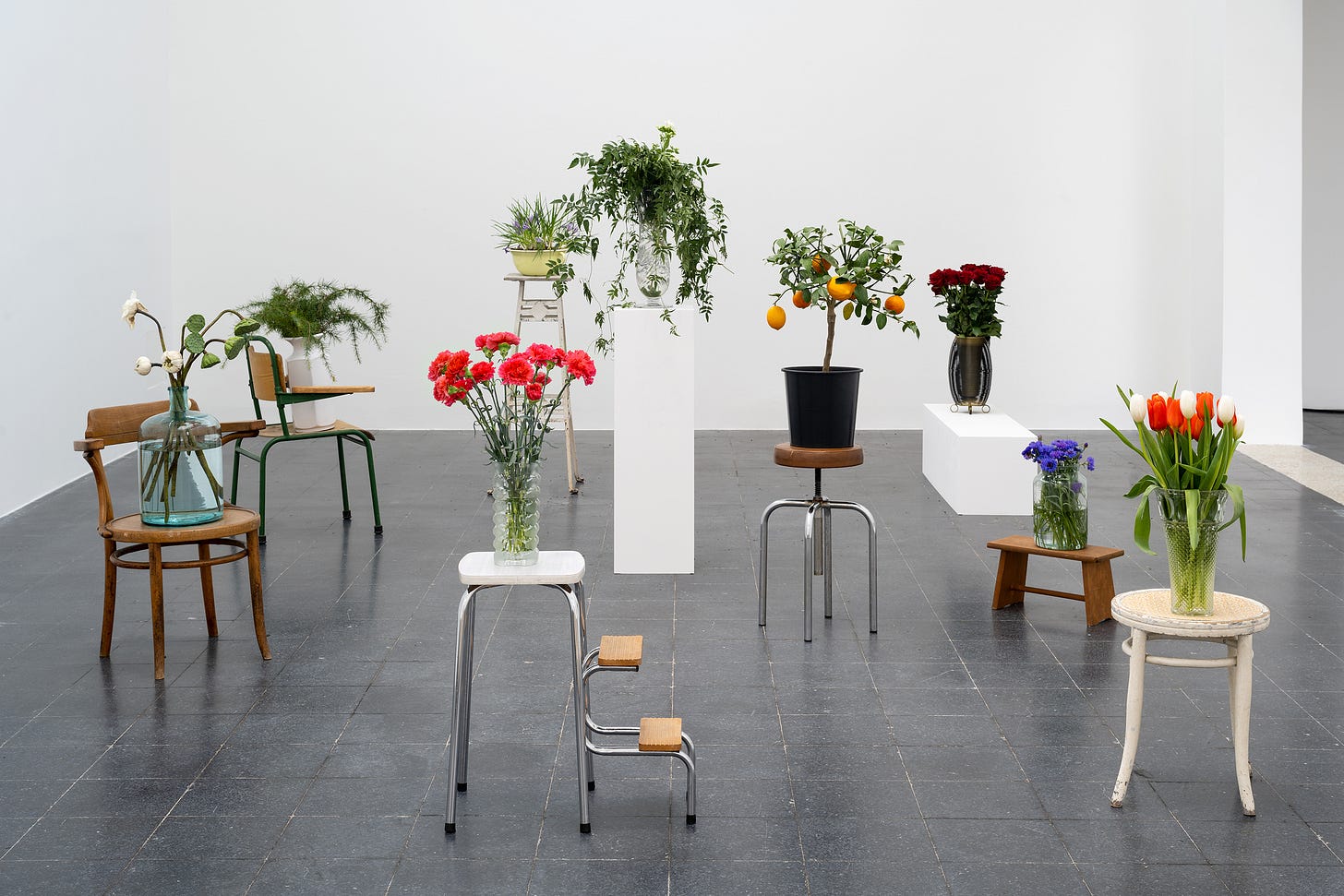The Venice Biennale 2024: The Giardini Pavilions (Part 4)
To continue the series, we look into a Wes Andersonian opera, gentle revolutions, and monuments breathing under water.
Egypt: Drama 1882 - دراما ١٨٨٢
Wael Shawky (Gen X, Egyptian) created a 45 minute long musical following the events of the Urabi Revolution (1879–1882) that culminated in the occupation of Egypt by Great Britain which would ultimately last until 1956.
Wael unfolds the story of national self-determination and diplomatic greed in eight acts set in a colorful, bright version of Alexandria: The Khedive, Egypt’s ruler, rejects Pasha Ahmed Urabi’s demands. The British plot to spark chaos that would justify an invasion. The killing of a donkey owner results in a violent clash between foreigners and Egyptians. The British navy attacks Alexandria and leaves the city devastated. In his final attempt to save Egypt from British occupation, Urabi is defeated by traitors from within, forced to leave the scene.
Notice how in this story, the Westeners are the foreigners, not the other Orientalist way around. In a Bridgertonian masquerade, Westeners are performed by people of color. And instead of pretened Arabic and orange tinted deserts of Hollywood movies, Wael's characters sing in Arabic, even those performing Europeans.

A donkey and a goose are part of the cast, too, I appreciate their mention by name in the final credits. Allthough Wael mostly worked with puppets in the past, he remains a puppeteer even while working with humans: The way the actors move painfully slowly, pushing and pulling, bending forwards and backwards, I squeeze my eyes, trying to find the invisible strings with wich Wael is orchestrating them. One of the beduins betraying Urabi is literally carried into the scene like a sack of potatoes and must be wound up almost like a machine to deliver his lines. As soon as a money bag falls into the hands of one of Urabi’s officers, he’s bending and twirling underneath the hands of his seducer like a snake hearing the charmer play his melody.
When the European leaders gather to decide how to handle the clash between Egyptians and foreigners, they rub their bodies against the assymetrical table that the British representative sits on top of. Their hands clasping the table seems to forshadow the Scramble for Africa, the conference that would take place two years later in Berlin with the European rulers gathering at a table to chop up Africa into colonies. When the British army arrives in Urabi’s camp, their confident formation with arms pointed upwards reminds me of Jacques-Louis David’s Oath of the Horatii (1784). In the final act, the Egyptian elites praise Queen Victoria and the end of bloodshed. The actors stand neatly in rows, turning slowly like manequins in a shop window or trophies to be admired. Order is reinstalled. But at what cost?

When Urabi leaves Egypt to the British in defeat, he leaves the theater and disappears behind the curtain which slowly closes, reminding of this play being a story told and not actual truth taken place. That’s what a drama is at the end of the day, storytelling. In Wael’s story, history doesn’t seem to be a story of determined heros and action-taking leaders, but one where people appear to be nothing more but grains of sand at the mercy of the wind of fate. It’s just the way Urabi proclaimed in his speech to his army in act seven: God supports the victory of whomever he chooses.
I am not a fan of the physical works inside the space. Eventough they reference the historical events of the Urabi revolution, Egyptian architecture and mythology, they rather feel like decorations to the main show which is the musical itself. I feel like the pavilion would be better off with the video screen only. These objects don’t even feel like proper props, tying in neatly into the immersive experience the way it worked at the French Pavilion two years ago in Zineb Sedira’s (Baby Boomer, Franco-Algerian) show Les rêves n’ont pas de titre / Dreams have no titles. Here, they appear as awkward space fillers. I’d rather expand the screen and the seating because best believe the floor is always packed with people entranced by Wael’s storytelling.

National Pavilion of Egypt, Giardini, La Biennale di Venezia
France: Attila cataract your source at the feet of the green peaks will end up in the great sea blue abyss we drowned in the tidal tears of the moon
The first time I entered the French pavilion, I felt unease. Eventhough I was surrounded by colorful threads and large ornamental objects covered in hardened liquids, I couldn’t help but think to myself: This might be our inevitable future. The gates of cities and fences of houses submerged in water, monuments floating in the sea, lanterns wrapped in fishing nets. Unlike more pathetic approaches that use in-your-face imagery to make you react to climate change, Julien Creuzet (Millennial, French-Caribbean) makes me grasp for air and my heart beat faster while falling into anxiety without explicitly trying to. I avoided this pavilion for weeks.

When I returned, I saw beauty. Julien connects his native Martinique, its colonial capital Paris, and the exhibition’s host Venice through water. French gates and fences along with fountains and monuments are released into the sea. 80 sculptures, covered and interwoven with what might be debris or decor (or both) turn into abstracted forms, branches even, that outgrow the rigid architectural forms they once were.
The summer heat mingles with the scents of lavender and other plants that are infused in the sculptural wells in the central room. Allowing to grow mold and bacteria, these fountains bring new life into the pavilion instead of eradicating it. These water-carrying sculptures take on humanoid forms, a bead necklace is woven through the eye of one. These beads refer to the history of enslavement that Venice was complicit in. Venetian rosetta beads were a commonly accepted currency for human trafficking.

Venetian references return through door knockers. They often carry a figure of Neptune, the God of the Sea, who protects the Venetian lagoon and the waterways surrounding its once mighty empire. In Julien’s exhibition, there’s a version of a door knocker I saw at Museo Correr and on a door on Venice’s Zattere on the south shore of the Dorsoduro neighborhood. He replaced Neptune with an orixa, a Caribbean deity. The colonized and the colonizers worship the same powers after all.
Apart from sculptures and scents, music fills the space. Julien performs a libretto he wrote in French, Creole and English, seeking the advice and support of orixas. His poetic pleas sound tender, at first I didn’t even recognize language but only perceived sound waves intensifying and ebbing like water.
Outside, a large-scale video joins the classicist ionic columns of the pavilion’s façade. The Parisian Fontaine des Quatre-Parties-du-Monde (1874) comes to life. The four female representations of Africa, America, Asia, and Europe carrying the globe over their heads get to move again, released from the stiff position they held for centuries.

National Pavilion of France, Giardini, La Biennale di Venezia
Austria: Anna Jermolaewa
Anna Jermolaewa (Gen X, Russian) points to how beautiful revolutions can be. In times of political upheaval just like now, it’s important to remember that new beginnings do not have to bring destruction, but new life can grow out of them.
For The Penultimate (2017), flower vases and plant potts take a seat in the left wing of the spacious, light-flooded pavilion. Always fresh, they are continuously swapped. These plants are the symbols of revolutions all around the world. Oddly, I have to think of a German idiom: Etwas durch die Blume sagen, or saying something through the flower. It describes a euphemism, tiptoeing around what really needs to be said through embellishment. Especially with the piano tinkling in the other wing, I can’t help but wonder whether political justice may only be demanded gently to be granted.

The piano sound from the other wing belongs to Anna’s video work Rehearsal for Swan Lake (2024) which is exactly what the title promises: Ballerinas practicing Pyotr Ilyich Tchaikovsky’s Swan Lake ballet. Eventhough composed back in 1875, Swan Lake has Russian culture in a chokehold until this very day (I remember sleeping through a Russian Grand Ballet performance that my parents took me to as a kid eventhough I insisted that I loved ballet).
In the wall text, Anna remembers that during times of political unrest when Russian leaders died, Swan Lake would fill screening time of national TV, beloved enough so that people wouldn’t get suspicious. By practicing this piece employed by the Russian government for censorship, the performers perpare for a possible new beginning (which suggests the fall of the final boss). I chuckle at the way the flowers on the other side seem to sit in the audience, enjoying the performance.

The courtyard and a smaller room focus on Anna’s experience as a fugitive. Research for Sleeping Positions (2006) is a 17 min. video of the artist trying to fall asleep on a bench in Vienna’s Westbahnhof station. Vulnerable and uncomfortable, she relives her experience of fleeing to Austria 17 years prior. Not only her personal situation changed from urgent refugee to safe artist, the environment did, too: The benches adapted hostile design to keep away the weary looking for rest. Behind the pavilion, Anna installed Untitled (Telephone Booths) (2024) using six real telephone booths from the Austrian refugee camp she was sheltered in. Carrying the graffiti and insciptions along with the homesickness and hopes of refugees from the past, they can still be used by visitors today.
In the room behind the ballet rehearsal, Anna placed Ribs (2022/24) which combines yet again protest with music. During the Soviet Union’s ban on Western music in the post-war period, people would copy record albums on discarded X-rays to hide them from the police. Anna puts these records back on a medical X-ray film viewer and plays selected records on a record player.
I remembered an act of protest back in 2020 that similarly involved a record player. During Russia’s most famous comedy competition КВН (so famous that Putin is occasionally spotted in the front row seats), the Belarussian team “Turing's Children” ended their final musical sketch refering to the ongoing repressions in their home country and the protests against long-term dictator Alexander Lukashenko. As the team captain delivered his speech, the record player started scratching. He stopped, slowly approached it and put down the disc. “You’re now witnesses of a historic moment”, he said. “The Belarussians change the record”. The audience burst out in applause of solidarity. But just like Lukashenko still rules in Belarus, who knows if the wind of change will arrive anytime soon in Russia.

National Pavilion of Austria, Giardini, La Biennale di Venezia
The 60th International Art Exhibition of La Biennale di Venezia closes on November 27, 2024. Read part 1-3 of my Biennale edit below:
Thank you for sticking around! This is my last newsletter for this year delivered from Venice. As I return to Cologne next week, I am grateful to another four beautiful months spent in my favorite city in the entire world. But don’t worry, I have enough Venice material to share with you even when back in Cologne. Follow me on Instagram to come along on art walks around the Rhineland.
See you soon!!!
Jennifer
The Gen Z Art Critic




